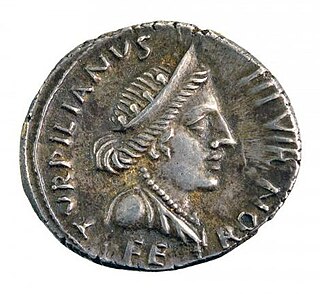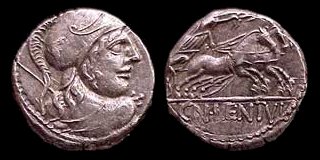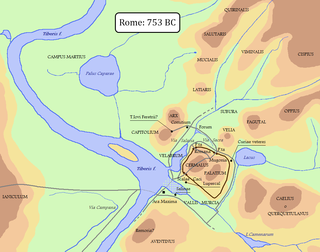Related Research Articles

Jupiter, also known as Jove, is the god of the sky and thunder, and king of the gods in ancient Roman religion and mythology. Jupiter was the chief deity of Roman state religion throughout the Republican and Imperial eras, until Christianity became the dominant religion of the Empire. In Roman mythology, he negotiates with Numa Pompilius, the second king of Rome, to establish principles of Roman religion such as offering, or sacrifice.

Fontus or Fons was a god of wells and springs in ancient Roman religion. A religious festival called the Fontinalia was held on October 13 in his honor. Throughout the city, fountains and wellheads were adorned with garlands.

In ancient Roman religion, the rex sacrorum was a senatorial priesthood reserved for patricians. Although in the historical era, the pontifex maximus was the head of Roman state religion, Festus says that in the ranking of the highest Roman priests, the rex sacrorum was of highest prestige, followed by the flamines maiores and the pontifex maximus. The rex sacrorum was based in the Regia.

The gens Mamilia was a plebeian family at ancient Rome during the period of the Republic. The gens was originally one of the most distinguished families of Tusculum, and indeed in the whole of Latium. It is first mentioned in the time of the Tarquins; and it was to a member of this family, Octavius Mamilius, that Lucius Tarquinius Superbus, the seventh and last King of Rome, betrothed his daughter. The gens obtained Roman citizenship in the 5th century BC, and some of its members must subsequently have settled at Rome, where Lucius Mamilius Vitulus became the first of the family to hold the consulship in 265 BC, the year before the First Punic War.

Gaius Duilius was a Roman general and statesman. As consul in 260 BC, during the First Punic War, he won Rome's first ever victory at sea by defeating the Carthaginians at the Battle of Mylae. He later served as censor in 258, and was appointed dictator to hold elections in 231, but never held another command.

In Etruscan and Sabine religion, Feronia was a goddess associated with wildlife, fertility, health, and abundance, also venerated by the Faliscans and later adopted into ancient Roman religion. As the goddess who granted freedom to slaves or civil rights to the most humble part of society, she was especially honored among plebeians and freedmen. Her festival, the Feroniae, was November 13 during the Ludi Plebeii, in conjunction with Fortuna Primigenia; both were goddesses of Praeneste.

In ancient Roman religion, the flamen Dialis was the high priest of Jupiter. The term Dialis is related to Diespiter, an Old Latin form of the name Jupiter. There were 15 flamines, of whom three were flamines maiores, serving the three gods of the Archaic Triad. According to tradition the flamines were forbidden to touch metal, ride a horse, or see a corpse. The Flamen Dialis was officially ranked second in the ranking of the highest Roman priests, behind only the rex sacrorum and before another flamines maiores and pontifex maximus.

The Septimontium was a proto-urban festival celebrated in ancient Rome by montani, residents of the seven (sept-) communities associated with the hills or peaks of Rome (montes): Oppius, Palatium, Velia, Fagutal, Cermalus, Caelius, and Cispius. The Septimontium was celebrated in September, or, according to later calendars, on 11 December. It was not a public festival in the sense of feriae populi, according to Varro, who sees it as an urban analog to the rural Paganalia.

The Equirria were two ancient Roman festivals of chariot racing, or perhaps horseback racing, held in honor of the god Mars, one 27 February and the other 14 March.
An Agonalia or Agonia was an obscure archaic religious observance celebrated in ancient Rome several times a year, in honor of various divinities. Its institution, like that of other religious rites and ceremonies, was attributed to Numa Pompilius, the semi-legendary second king of Rome. Ancient calendars indicate that it was celebrated regularly on January 9, May 21, and December 11.

Marriage in ancient Rome was a fundamental institution of society and was used by Romans primarily as a tool for interfamilial alliances. Roman marriage was a monogamous institution: Roman citizens could have only one spouse at a time but were allowed to divorce and remarry. This form of monogamy in Greco-Roman civilization may have arisen from the relative egalitarianism of democratic and republican city-states. Early Christianity embraced this ideal of monogamous marriage, and perpetuated it as an essential element in many later Western cultures.

Arx is a Latin word meaning "citadel". In the ancient city of Rome, the arx was located on the northern spur of the Capitoline Hill, and is sometimes specified as the Arx Capitolina.

In ancient Roman religion and mythology, Mars was the god of war and also an agricultural guardian, a combination characteristic of early Rome. He was the son of Jupiter and Juno, and was pre-eminent among the Roman army's military gods. Most of his festivals were held in March, the month named for him, and in October, the months which traditionally began and ended the season for both military campaigning and farming.

Ancient Carthage was an ancient Semitic civilization centered in North Africa. Initially a settlement in present-day Tunisia, it later became a city-state and then an empire. Founded by the Phoenicians in the ninth century BC, Carthage reached its height in the fourth century BC as one of the largest metropolises in the world. It was the centre of the Carthaginian Empire, a major power led by the Punic people who dominated the ancient western and central Mediterranean Sea. Following the Punic Wars, Carthage was destroyed by the Romans in 146 BC, who later rebuilt the city lavishly.
Lucius Valerius Flaccus became suffect consul of the Roman Republic in 86 BC when Gaius Marius, the consul prior, unexpectedly died. He was elected to complete Marius's term in office. Marius had fought a series of civil wars against Lucius Cornelius Sulla, both leaders of their respective factions: the populares and the optimates. Flaccus was considered a staunch supporter of Marius and Lucius Cornelius Cinna; the leaders of the Marian-Cinna faction within the populares. Cinna was Marius's consular collegae and succeeded Marius as faction leader.

The gens Cloelia, originally Cluilia, and occasionally written Clouilia or Cloulia, was a patrician family at ancient Rome. The gens was prominent throughout the period of the Republic. The first of the Cloelii to hold the consulship was Quintus Cloelius Siculus, in 498 BC.

Numerius is a Latin praenomen, or personal name, usually abbreviated N. The name was never especially common, but was used throughout the period of the Roman Republic, and into imperial times. The feminine form is Numeria. The praenomen also gave rise to the patronymic gens Numeria.

The vocabulary of ancient Roman religion was highly specialized. Its study affords important information about the religion, traditions and beliefs of the ancient Romans. This legacy is conspicuous in European cultural history in its influence on later juridical and religious vocabulary in Europe, particularly of the Christian Church. This glossary provides explanations of concepts as they were expressed in Latin pertaining to religious practices and beliefs, with links to articles on major topics such as priesthoods, forms of divination, and rituals.
The Ciconiae Nixae was a landmark, or more likely two separate landmarks, in the Campus Martius of ancient Rome. In A New Topographical Dictionary of Ancient Rome, Lawrence Richardson regards a single site called Ciconiae Nixae as "hypothetical", noting that the subject "has long exercised topographers." The two words are juxtaposed in the regionary lists and located in Region IX near the Tiber River. The 4th-century calendar of Filocalus notes vaguely that the October Horse happened ad nixas, "at the Nixae", suggesting that the regionaries' Ciconiae ("Storks") ought to be taken as a separate entry. Inscriptional evidence also indicates that the Ciconiae was a separate landmark, and that it had to do with wine shipments brought in on the Tiber.

In ancient Roman religion, the October Horse was an animal sacrifice to Mars carried out on October 15, coinciding with the end of the agricultural and military campaigning season. The rite took place during one of three horse-racing festivals held in honor of Mars, the others being the two Equirria on February 27 and March 14.
References
- ↑ Sarolta A. Takács, Vestal Virgins, Sibyls, and Matrons: Women in Roman Religion (University of Texas Press, 2008), p. 58.
- ↑ CIL 6.338377 ( ILS 7242) and Festus 116, 117 L, as cited by C. Bennett Pascal, "October Horse," Harvard Studies in Classical Philology 85 (1981), p. 279, notes 86 and 87.
- ↑ H.H. Scullard, A History of the Roman World, 753 to 146 BC (Routledge, 1935, 1980, reprinted 2003), p. 61.
- ↑ Lawrence Richardson, A New Topographical Dictionary of Ancient Rome (Johns Hopkins University Press, 1992), p. 403; the evidence for this is the dating of the inscription.
- ↑ As Festus states: Mamilia turris intra Suburae regionem a Mamilio nomen accepit.
- ↑ Pascal, "October Horse," pp. 279–280.
- ↑ "As inconceivably bad as if Guy Fawkes were to escape the bonfire": Pascal, "October Horse," p. 280, note 89.
- ↑ William Warde Fowler, The Roman Festivals of the Period of the Republic (London, 1908), p. 242, note 4.